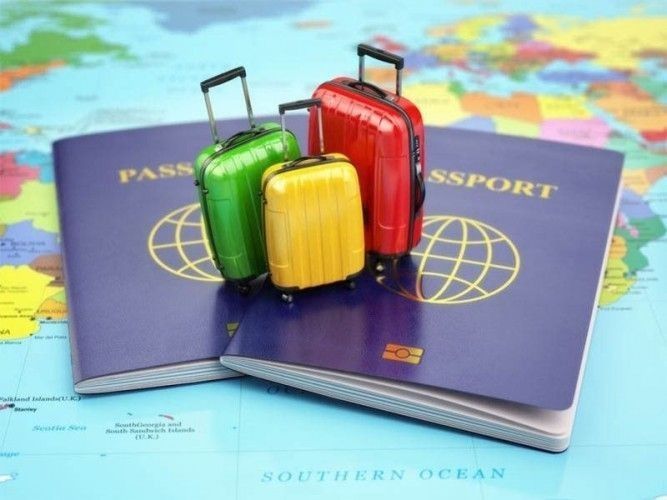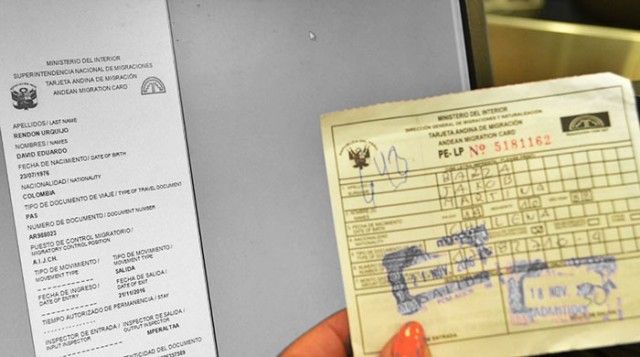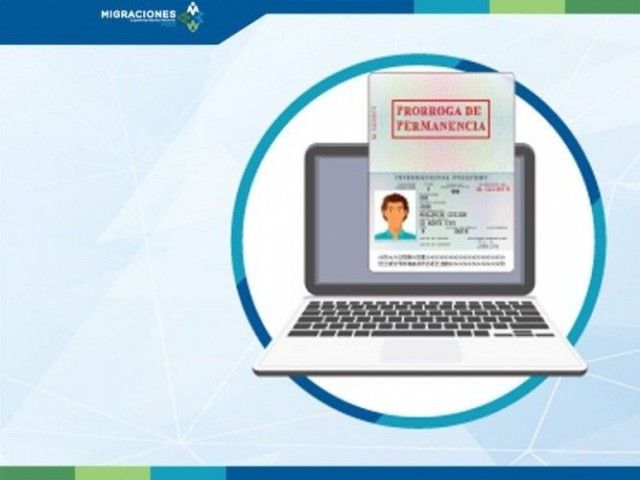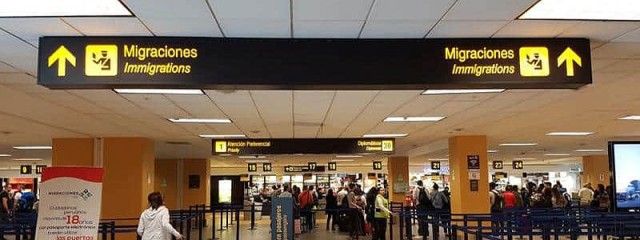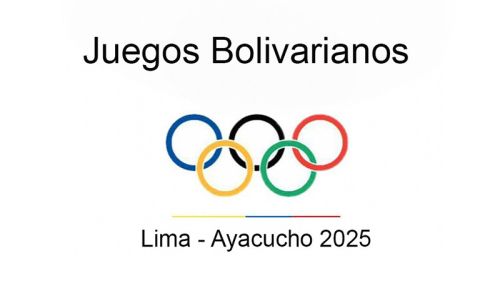When planning a trip to Peru, eventually bureaucratic and visa related matters come to mind. As finding detailed and up-to-date information on this topic can be challenging, we put together comprehensive information and advise on all Peruvian tourist visa issues that might pop up.
Content overview
- Peruvian tourist visa in a nutshell
- Do I need a visa to enter Peru as a tourist?
- How and where to apply for a Peruvian tourist visa
- How long can I stay in Peru as a tourist?
- Entering Peru
- How many days did I get when entering Peru?
- Extension of Peruvian tourist visa
- Expired Peruvian tourist visa
- Border-hopping Peru
- Do I need a return ticket when travelling to Peru?
- Can I work in Peru when on a tourist visa?
- Can I study or do an internship in Peru on a tourist visa?
- Can I sign legally binding documents in Peru when on a tourist visa?
- Can I volunteer in Peru when on a tourist visa?
Peruvian tourist visa in a nutshell
- Nationals of some countries need a tourist visa and have to apply for it at a Peruvian consulate before coming to Peru; see PDF under attachments at the end of this really long article to find out if you have to apply for a tourist visa.
- Nationals of other countries can travel visa-free to Peru and receive a "temporary authorization to enter and stay as a tourist for a certain time" (sounds fancy but since the end of May 2023 it's nothing more than an entry in the Migraciones database) at the Peruvian border or airport upon entry.
- Most nationalities that can travel visa-free to Peru are allowed to stay up to 90 days in a 180-day period and a max. of 183 days in a 365-day period for touristic, recreational or health purposes (see attached PDF at the end of this really long article to find out if you can enter Peru visa-free and how long you can stay).
- Peruvian tourist visas issued at a consulate are mostly multiple entry visas.
- The "temporary authorizations" for those who can travel to Peru visa-free are single entry.
- All visitors coming to Peru need a passport with at least 2 free pages in the visa section that is valid for at least another 6 months upon arrival.
- As in nearly all countries around the globe, foreigners are not allowed to work in Peru or receive a remuneration for any kind of professional activity in Peru while being in the country on a tourist visa / temporary authorization to enter as a tourist.
- Tourists can only sign legally binding documents (work contract, sworn statement needed, for example, for changing your immigration status, car or apartment purchase, marriage license, ...) with a so called "Permiso para firmar contratos".
- Extensions of tourist visas / authorizations to enter as a tourist are not possible anymore.
Do I need a visa to enter Peru as a tourist?
Peru is a very welcoming country that signed agreements with many countries, allowing the citizens to travel visa-free to Peru for tourism. Citizens of below mentioned countries do not have to apply for a tourist visa at a Peruvian embassy or consulate before coming to the county. They only need a passport with at least 2 free pages in the visa section that is valid for at least another 6 months upon arrival to get a “temporary authorization to enter and stay as a tourist for a certain time” (sounds great, but today is just an entry in the Migraciones database) directly at the immigration control at the airport or border. For a more detailed listing, please have a look at our PDF "Visas for Peru by country and allowed length of stay" at the end of this very long article for clarification.This PDF is an English translation of the original from the Peruvian Ministry of Foreign Affairs which can be found here.
Following nationals do not need a tourist visa for Peru
- South America: Citizens of all South American countries except Venezuela
- Central America: Citizens of most Central American countries (exception Cuba, El Salvador, Haiti and Nicaragua)
- North America: Citizens of the United States, Canada and Mexico
- Europe: Citizens of all countries within the European Union and of Switzerland and the UK
- Africa: Citizens of South Africa
- Asia: Citizens of Brunei, Indonesia, Israel, Indonesia, Israel, Japan, Malaysia, Philippines, Singapore and Thailand as well as some citizens of China and India (according to a supreme decree from September 2016 Chinese citizens and according to a supreme decree from March 2017 Indian citizens with a permanent (!) residence visa or a visa with a validity of at least (!) 6 months for the USA, Canada, any country belonging to the Schengen area, UK or Australia can travel to Peru visa-free; other Chinese and Indian nationals still have to apply for a tourist visa at a Peruvian embassy or consulate!)
- Oceania: Citizens of Australia and New Zealand
How and where to apply for a Peruvian tourist visa
As already mentioned above, citizens of some countries need a visa even for touristic and recreational purposes (please have a look at our PDF "Visas for Peru by country and allowed length of stay" at the end of this very long article for clarification.). As Peru doesn’t offer online visa applications, these nationals have to apply for a tourist visa at a Peruvian diplomatic mission that has jurisdiction over their domicile or country of residence.
Requirements for the tourist visa application at a Peruvian Consulate
Required documents to apply for a tourist visa include, but may not be restricted to:
- Application form
- Valid passport
- Round-trip ticket
- Hotel reservation, tourist package reservation or invitation letter
- Proof of sufficient funds
- Passport photos
- Proof of legal residency in the area or country under the consulates jurisdiction
- Receipt for paid application fee
Please be aware that the consulate, where you apply, will invite you to a personal interview.
On the website of the Peruvian Ministry of Foreign Affairs (RREE) you find a world map showing all Peruvian consulates abroad. Just click on a marker and the address, phone number, e-mail and - if available - website of the consulate appears.
There is no Peruvian embassy or consulate in my country. Where do I apply?
Especially in Africa and Asia, where the residents of most countries still have to apply for a tourist visa, Peruvian consulates are scarce, website aren’t up-to-date and e-mails often aren't answered. So, finding the correct consulate, getting information and applying for the visa can be quite a challenge. The Peruvian Ministry of Foreign Affairs unfortunately doesn't consistently publish which consulates have jurisdiction over which regions/countries. Therefore, if there is no Peruvian consulate in your country of residence, the only way to find out where and how to apply for a visa is by getting in contact with the nearest Peruvian diplomatic mission (which sometimes isn’t near at all) and ask if they are in charge or know who is.
How long can I stay in Peru as a tourist?
In March 2017, a new Peruvian Foreigner Law (Decreto Legislativo 1350) went into effect, allowing tourists who can travel visa-free to Peru for touristic, recreational or health purposes to stay for a maximum of 183 days within a 365-day period. Shortly afterwards, the Peruvian Ministry of Foreign Affairs excluded Schengen States nationals from this general rule, allowing them to stay for up to 90 days within a 180-day period. Then, in June 2019, a new publication of the Peruvian Ministry of Foreign Affairs (RREE) eliminated the general 183 days in a 365-day period for most nationalities, who can travel to Peru visa-free, and divided it into two times 90 days in two consecutive 180-day period.
While the modification of Peruvian Foreigner Law (Decreto Legislativo 1582), which was published in November 2023, confirms that foreign nationals can stay as tourists in Peru for a maximum of 183 days in a 365-day period, the RREE publication is still in place.
So, today, most nationalities who don’t have to apply for a tourist visa before coming to Peru, are given up to 90 days in a 180-day period upon entry; the 180-day period isn't per half year from January to June or July to December but calculated from your first entry.
Brazilian, Chilean, and Mexican nationals as well as those Chinese and Indian passport holders with a permanent residency or a visa with a validity of at least 6 months for the USA, Canada, any country belonging to the Schengen area, UK or Australia, who are still allowed visa-free up to 180 days should know that Peruvian immigration often only gives them 90 days as well upon entry.
In case you have to apply for a tourist visa before coming to Peru, it’s up to the consulate to decide the number of days you can visit the country. Be aware that even if the consulate issued a 180-day tourist visa, often immigration officers only give you 90 days when you enter.
While you generally can expect to get the full days allowed (if you haven’t overstayed your welcome before excessively or if you haven’t been in Peru before and now try to re-enter the country before your 180-day period is over), you should be aware that you aren't entitled to getting the full 90 (or 180) days. As everywhere around the globe, it’s at the discretion of the immigration officer if he or she lets you enter at all and how many days you are allowed to stay.
Please see our PDF " Visas for Peru by country and allowed length of stay" at the end of this very long article to find out if you need a visa to enter Peru or if you can travel visa-free and how long you can stay - this PDF is an English translation of the original from the Peruvian Ministry of Foreign Affairs which can be found here.
Entering Peru
With the introduction of the new Immigration Law in 2017 and progressive digitalization, especially during Covid times, entering Peru today is a quite easy, seemingly organized and at least for now usually a quick process.
Requirements
After a complete shutdown, Peru re-opened the country for international air travel in October 2020. Land borders only re-opened in mid-February 2022.
Finally, on November 1, 2022, the State of Emergency in Peru was lifted and all Covid entry requirements as well as all other regulations and restrictions that were in place to avoid the spreading of Covid were repealed.
So, entering Peru is back to "normal" and you just need your passport with at least 2 free pages in the visa section that is valid for at least another 6 months upon arrival and, if you have to apply for a tourist visa before coming to Peru, your visa stamp.
Entry process
After leaving the plane (or at the border), just follow the flow to the immigration control; note: at the beginning of 2023, automated passport control machines were finally put into operations, but for the moment are reserved for Peruvian passport holders.
At immigration control just present your passport (which should have at least 2 free pages in the visa section and must be valid for at least another 6 months upon arrival).
While during the height of the Corona pandemic Peru eliminated the stamping of passports when entering the country, in May 2022 the entry stamp was re-introduced just to eliminate it again at the end of May 2023 for those entering Peru on international flights; and, unfortunately, this time it seems for good.
Today, your entry and the number of days you got is just automatically registered and nothing more than an entry in the Migraciones database. Now tourist once again don't have anything in writing on how long they are allowed to stay as a tourist.
So, to find out how long you can be in Peru as a tourist, you must ask the immigration officer and, if you want to have a confirmation "in writing" or need proof when you entered or left the country, you have to check online. Our article "How many days did I get when entering Peru?" explains how it's done
Once you are finished at the immigration counter, proceed to the baggage carousel and claim your luggage.
Clearing customs
Since June 2022, the good old customs declaration form has served its time and was replaced by the App "Bienvenido al Perú" which is available on iOS and Android and in short details which items have or haven’t to be declared. So, if you have something to declare, download the App, fill in required fields and once in Peru proceed to the customs counters at your point of entry.
Peruvian customs urges travelers to know and comply with Peruvian customs regulations. So, it's up to you to inform yourself. Our article “What you can & can’t bring into Peru” helps with this.
- If you have nothing to declare, you don’t have to do anything. Clear immigration, get your luggage and proceed to the exit.
- If you have something to declare, download the App "Bienvenido al Perú", follow the instructions and fill in the form within 48h prior to your arrival in Peru. Once in Peru, proceed to the customs counters at your point of entry.
- If you carry more than US$ 10,000, download the App "Bienvenido al Perú", follow the instructions and fill in the form within 48h prior to your arrival in Peru. Once in Peru, proceed to the customs counters at your point of entry.
We highly recommend to be honest, as failing to declare taxable or dutiable items can result in fines of 50% of the custom value of the items if caught; failing to declare currency over US$ 10,000 results in a 30% fine on the amount you carry with you.
Before you can leave the airport, you and your luggage are scanned and you might be asked to follow an official for a thorough check of your luggage.
You made it! Welcome to Peru!
How many days did I get?
After not stamping passports during peak Corona times, in May 2022, tourists entering the country finally got an entry stamp again, making it easy to check how long they could stay in Peru.
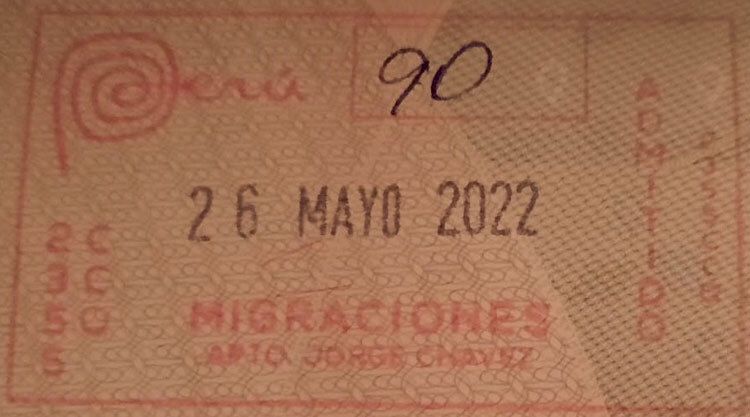
Unfortunately, at the end of May 2023 Peru eliminated the entry stamp again for those entering Peru on international flights. And, unfortunately, this time it seems for good as successively stamping at land borders is stopped as well.
So now, the only way to find out how many days you are allowed to stay as a tourist in Peru, is to ask the immigration officer or, if you prefer a written confirmation check online. Our article “How many days did I get when entering Peru?” explains in detail the legal background and gives you options to check the number of days you are allowed to stay in Peru as a tourist.
Extension of a Peruvian tourist visa
For the past two decades, every few years Peruvian regulations changed, allowing or denying foreigners to extend their stay as a tourist in the country.
Since August 2021, foreign tourists cannot extend their time in Peru anymore. However, this general “no” for tourist visa extensions was softened with the implementation of new Migraciones administrative regulations on October 22, 2023, which allow foreign nationals from member countries of the Andean Community, and only these (!), to extend their stay as a tourist again and officially abolished with the new Foreigner Law, Decreto Legislativo 1582 on November 14, 2023.
The new Foreigner Law, Decreto Legislativo 1582, published on November 14, 2023, states that foreign tourists can stay in Peru for 183 accumulated days in a 365-day period; so, half a year within one year. It further describes that in case foreign tourists don't get the full 183 days, an extension can be granted until the 183 days are reached, unless international agreements or conventions determine a shorter period or don't allow extensions.
As till today (March 2025) the administrative regulations, called TUPA, indispensable for the implementation of the new Foreigner Law, still haven't been published, we don't know, which foreign nationals might one day be allowed to extend again or for which nationalities there might be restrictions or when foreigners might be able to extend or how it works. For now, the only foreign nationals, who already now can extend their stay as a tourist, are Bolivians, Ecuadorians and Colombians, which is stated in the TUPA from October 2023.
Even though it's now already over a year since the publication of the new Foreigner Law, we still can only wait and hope for more official news. You can find detailed background information on the topic in our article "Tourist Visa extension in Peru".
Expired Peruvian tourist visa
Like in any other country, we recommend respecting the rules and regulations here in Peru, including the time you are allowed to stay in the country as a tourist.
However, if you overstayed your stay as a tourist a few days, weeks or even months - at least for now - you rarely have to fear extreme consequences. When leaving Peru you just have to pay a fine of 0.1% of an UIT (S/ 5.35 in 2025) per day you overstayed. The fee must be paid before leaving the country. In our article "Peruvian Overstay fine for tourists" we explain the details
Once the fine is paid, you can usually leave Peru with no reprisals.
Those having excessively overstayed their welcome (we are talking about many months or even years), however, might be additionally sanctioned with a re-entry ban for a certain time.
Border-hopping Peru
Between 2008 and 2017, border hopping was an easy and popular way to “renew” your tourist visa. Back then, the Peruvian foreigner law stated that visitors can enter Peru for touristic, recreational, or health purposes for 183 days. It however didn't mention if the 183 days were per year or per visit. So, many foreigners used this little gap in the old Peruvian immigration law to live in the country on a tourist visa. As soon as their visa was about to expire, they just crossed the border, stayed 5 minutes, a day or two, in one of Peru’s neighboring countries and returned asking immigrations for another 183 days. For years, this worked absolutely fine.
After the introduction of the new foreigner law (Decreto Legislativo 1350) in 2017 which rectified the loophole and the reduction of the time most nationalities can stay visa-free in Peru two years later, Peruvian border officials got stricter and increasingly applied the new rules giving foreigners only the back then allowed 90 or 183 days in a 180 days or 365 days period and didn’t let border-hoppers re-enter (or only for a few days) when they already stayed the maximum allowed time as visitor in the country.
Then in March 2020, Covid hit the country, borders were closed and Migraciones worked hard on digitalizing certain processes and procedures. Now, all entries and exits are saved in the Migraciones database and can be retrieved at all control points.
Since August 2021, travelers, who already stayed their allowed 90 days in a 180-day period, reported that when trying to re-enter the country at Lima’s airport before their 180-day period was over, that they were scolded and only given anything between 3 and 30 days. And according to reports from travelers who tried to re-enter Peru at a land border after already having stayed their 90 days, immigrations often only gave a few days up to a month. Others, however, reported that they had no problem re-entering Peru before their 180-day period was over and still got the full 90 days, but only if they hadn't already stayed the max of 183 days in a year.
So, be aware that it's always at the discretion of the immigration officer and his/her evaluation of your situation how long you are allowed to stay in Peru.
One way or the other, the times of border-hopping seem to be over and foreigners wanting to stay longer in Peru should work on getting a "real" temporary visa (for example, a temporary work visa or a temporary student visa) or a residence visa. Our Visa Guide explains the most common temporary and residence visas including the legal background, requirements, necessary preparation work and a step-by-step application guide.
Do I need a return ticket when travelling to Peru?
Peruvian law requires that foreign visitors need a return or onward passage out of the country if they aren't residents, proving that they leave the country when the visa or temporary authorization to enter expires. But the law doesn't state that this return or onward passage must be an airline ticket; it could be anything proving that you leave Peru when the time comes.
When entering the country, Peruvian immigration officials hardly ever ask to see this proof. The ones executing above regulations are usually the airlines. As they could be held responsible and have to fly you back, if denied entry to Peru, most airlines require a return or onward flight ticket to even let you check-in to your flight to Peru.
So, if you plan to come to Peru on a one-way ticket, it’s best to check the requirements of your carrier. Some insist on a flight ticket showing that you leave the country, others accept a reservation for a return flight, a few are happy with a bus ticket and there are as well airlines that let you fly with just a one-way ticket.
If your airline requests a return or onward ticket, you could always make a reservation for one, print the confirmation, and then depending on the agency, you either don't pay it and let it expire or cancel it within a certain time. Other options include buying a fully refundable ticket or, more affordable, "renting" a ticket.
Can I work in Peru when on a tourist visa?
No!
A Peruvian tourist visa / temporary authorization for tourists allows entry for touristic, recreational, or health purposes only. Even though there are quite a few foreigners working in Peru for a Peruvian company on a tourist visa, Peruvian law explicitly prohibits to work in Peru for a Peruvian company or to receive a remuneration for any kind of professional activity in Peru while visiting the country as a tourist.
Can I study or do an internship in Peru on a tourist visa?
Generally no, sometimes yes.
For more information, please have a look at our detailed article "Peruvian Student Visa".
Can I sign legally binding documents in Peru when on a tourist visa?
No!
Before signing a legally binding document (work contract, sworn statements, car or apartment purchase, marriage license, ...) tourists have to apply for a so called "Permiso para firmar contratos". Our article "Permit to sign contracts" explains in detail how it works and what you have to do.
Can I volunteer in Peru when on a tourist visa?
Officially, no! But in reality, it's done all the time. Find more information in our article "Peruvian Volunteer Visa".
Please note: We from LimaEasy are not the Peruvian immigration authority Migraciones or a Peruvian consulate. All information is published to our best knowledge and should be seen as general guidance introducing you to Peruvian regulations and procedures. All information is subject to change, as regulations, requirements, and processes can change quickly without prior notice! Therefore, we recommend checking the current regulations with the nearest Peruvian consulate or, if you are already in Peru, with Migraciones!


